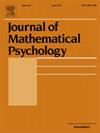A concise mathematical description of active inference in discrete time
IF 1.5
4区 心理学
Q2 MATHEMATICS, INTERDISCIPLINARY APPLICATIONS
引用次数: 0
Abstract
In this paper we present a concise mathematical description of active inference in discrete time. The main part of the paper serves as a basic introduction to the topic, including a detailed example of the action selection mechanism. The appendix discusses the more subtle mathematical details, targeting readers who have already studied the active inference literature but struggle to make sense of the mathematical details and derivations. Throughout, we emphasize precise and standard mathematical notation, ensuring consistency with existing texts and linking all equations to widely used references on active inference. Additionally, we provide Python code that implements the action selection and learning mechanisms described in this paper and is compatible with pymdp environments.
离散时间主动推理的简明数学描述
本文给出了离散时间主动推理的简明数学描述。论文的主要部分是对课题的基本介绍,包括一个动作选择机制的详细示例。附录讨论了更微妙的数学细节,目标读者谁已经研究了积极的推理文献,但努力使数学细节和推导的意义。在整个过程中,我们强调精确和标准的数学符号,确保与现有文本的一致性,并将所有方程与广泛使用的主动推理参考文献联系起来。此外,我们提供了Python代码来实现本文中描述的动作选择和学习机制,并且与pymdp环境兼容。
本文章由计算机程序翻译,如有差异,请以英文原文为准。
求助全文
约1分钟内获得全文
求助全文
来源期刊

Journal of Mathematical Psychology
医学-数学跨学科应用
CiteScore
3.70
自引率
11.10%
发文量
37
审稿时长
20.2 weeks
期刊介绍:
The Journal of Mathematical Psychology includes articles, monographs and reviews, notes and commentaries, and book reviews in all areas of mathematical psychology. Empirical and theoretical contributions are equally welcome.
Areas of special interest include, but are not limited to, fundamental measurement and psychological process models, such as those based upon neural network or information processing concepts. A partial listing of substantive areas covered include sensation and perception, psychophysics, learning and memory, problem solving, judgment and decision-making, and motivation.
The Journal of Mathematical Psychology is affiliated with the Society for Mathematical Psychology.
Research Areas include:
• Models for sensation and perception, learning, memory and thinking
• Fundamental measurement and scaling
• Decision making
• Neural modeling and networks
• Psychophysics and signal detection
• Neuropsychological theories
• Psycholinguistics
• Motivational dynamics
• Animal behavior
• Psychometric theory
 求助内容:
求助内容: 应助结果提醒方式:
应助结果提醒方式:


